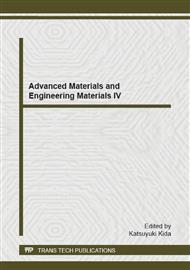[1]
Budak E., Altintas Y. Modeling and avoidance of static form errors in peripheral milling of plates. International Journal of Machine Tools and Manufacture 1995; 35(3): 459-476.
DOI: 10.1016/0890-6955(94)p2628-s
Google Scholar
[2]
Sarhan A, Sayed R, Nassr A A, et al. Interrelationships between cutting force variation and tool wear in end-milling. Journal of Materials and Processing Technology 2001; 109(3): 229-235.
DOI: 10.1016/s0924-0136(00)00803-7
Google Scholar
[3]
Kim S K, Lee S Y. Chatter prediction of end milling in a vertical machining center. Journal of Sound Vibration 2001; 241(4): 567-586.
DOI: 10.1006/jsvi.2000.3144
Google Scholar
[4]
Altintas Y, Spence A. End milling force algorithms for CAD systems. Annals of the CIRP 1991; 40(1): 31-34.
DOI: 10.1016/s0007-8506(07)61927-1
Google Scholar
[5]
Budak E, Altintas Y, Armarego E J A. Prediction of milling force coefficients from orthogonal cutting data. Transactions of the ASME Journal of Manufacturing Science and Engineering 1996; 118(2): 216-224.
DOI: 10.1115/1.2831014
Google Scholar
[6]
Gradisek J, Kalveram M, Weinert K. Mechanistic identification of specific force coefficients for a general end mill. International Journal of Machine Tools and Manufacture 2004; 44(4): 401-414.
DOI: 10.1016/j.ijmachtools.2003.10.001
Google Scholar
[7]
Kline W A, De Vor R E. The effect of runout on cutting geometry and forces in end milling. International Journal of Machine Tool Design and Research 1983; 23(2-3): 123-140.
DOI: 10.1016/0020-7357(83)90012-4
Google Scholar
[8]
Sutherland J W, De Vor R E. an improved method for cutting force and surface error prediction in flexible end milling systems. Transactions of the ASME Journal of Engineering for Industry 1986; 108(4): 269-279.
DOI: 10.1115/1.3187077
Google Scholar
[9]
Wang J J, Liang S Y. Chip load kinematics in milling with radial cutter runout. Transactions of the ASME Journal of Engineering for Industry 1996; 118(1): 111-116.
DOI: 10.1115/1.2803631
Google Scholar
[10]
Wan M, Zhang W H. Calculation of chip thickness and cutting forces in flexible end milling. International Journal of Advance Manufacturing Technology 2006; 29(7): 637-647.
DOI: 10.1007/s00170-005-2572-6
Google Scholar
[11]
Wan M, Zhang W H. New cutting force modeling approach for flat end mill. Chinese Journal of Aeronautics. 2007; 20: 282-288.
DOI: 10.1016/s1000-9361(07)60045-4
Google Scholar
[12]
A. O'Connor, M. Ramulu. The Effects of Machining Induced Damage on Flexural Strength of Low Density Carbon Foam, paper present at the ASME IMECE Confrence, Houston Tx, Nov. 9-15.
Google Scholar
[13]
A. O'Connor, M. Ramulu and J. Miller, Machining of Porous Materials for Aerospace Component Manufacturing, paper presented at the 2011 SME Composite Manufacturing Conference, Dayton OH, April 12-14.
Google Scholar
[14]
Altintas Y. Manufacturing Automation: metal cutting mechanics, machine tool vibrations, and CNC design. Cambridge University Press. (2012).
DOI: 10.1017/cbo9780511843723
Google Scholar
[15]
UMECO/Advanced Composites Group Ltd. CB1100 Product Information. Retrieved fromhttp: /www. advancedcomposites. co. uk/tooling_archived_news_index_2009. html#cb110.
Google Scholar


